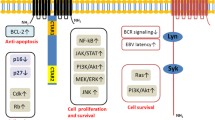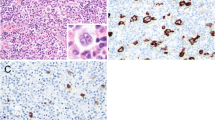Summary
Epstein-Barr virus (EBV) is a causative agent of malignant lymphomas occurring in immunocompromised hosts. Similar lymphoid tumors can be induced in mice with severe combined immunodeficiency (SCID mice) by transplanting human B-cells with latently infected EBV. We have previously observed that when apparently EBV-negative lymphomas were engrafted into SCID mice, 11 of 18 T-cell non-Hodgkin's lymphomas (NHLs) produced EBV associated lymphomas, but only 2 of 30 engrafted with B-NHLs. Previous studies suggested that EBV-infected cell inducing lymphomas in SCID mice may preferentially exist in T-cell NHL tissues. To prove this assumption, in situ hybridization (ISH) using oligonucleotide probes for EBV-encoded small RNAs 1 (EBER1) was used in this study to demonstrate EBV-bearing lymphocytes in NHL tissues. It was found that EBV-bearing cells existe in 9 of the 10 T-cell NHL surgical specimens. By contrast, in B cell NHLs, only 2 of 10 carried EBV-bearing cells. Further semi-quantitative analysis demonstrated that apparently significantly more EBV-bearing cells were present in T-cell NHL tissues than in B-cell NHLs. Moreover, these EBV-bearing cells in lymphoma tissues were shown to be of B-cell lineage, by the combinated analysis of immunostaining with CD20 and ISH with EBER1. These results indicated the increase of EBV-bearing B-cells in T-cell NHL tissues, suggesting the activation of B-cells with latently infected EBV by neoplastic T-cells.
Similar content being viewed by others
References
Bosma GC, Custer RP, Bosma MJ (1983) A severe combined immunodeficiency mutation in the mouse. Nature 301: 527–530
Cen H, Williams PA, McWilliams HP, Breing MC, Ho OO, McKnight JL (1983) Evidence for restricted Epstein-Barr virus latent gene expression and anti-EBNA antibody response in solid organ transplant recipients with posttransplant lymphoproliferative disorders. Blood 81: 1393–1403
Chen CL, Sadler RH, Walling DM, Su IJ, Hsieh HC, Raab-Traub N (1993) Epstein-Barr virus (EBV) gene expression in EBV-positive peripheral T-cell lymphomas. J Virol 67: 6303–6308
Fukayama M, Ibuki T, Hayashi Y (1993) Epstein-Barr virus in pyothorax-associated pleural lymphoma. Am J Pathol 143: 1044
Gaffey MJ, Weiss LM (1992) Association of Epstein-Barr virus with human neoplasia. Pathol Ann 27: 55–74
Harabuchi Y, Yamanaka N, Kataura A, Imai S, Kinoshita T, Mizuno F, Osato T (1990) Epstein-Barr virus in nasal T-cell lymphomas in patient with iethal middline granuloma. Lancet 335: 128–130
Herbst H, Dallenbach F, Hummel M, Niedobitek G, Pileri S, Muller-Lantzsch N, Stein H (1991) Epstein-Barr virus latent membrane protein expression in Hodgkin and Reed-Sternberg cells. Proc Natl Acad Sci USA 88: 4766–4770
Hironaka T, Nagasaki M, Morikawa S, Hirai K (1993) Detection of Epstein-Barr virus transcripts in chemically or immunologically-activated cells and in a null cell-line (HLN-STL-C) by in situ hybridization with alkaline phosphatase-linked oligonucleotide probes. J Virol Metch 44: 141–154
Howe JG, Steitz JA (1986) Localization of Epstein-Barr virus-encoded small RNAs by in situ hybridization. Proc Natl Acad Sci USA 83: 9006–9010
Hsu SM, Raine L, Fanger H (1981) Use of avidin-biotin-peroxidase complex (ABC) in immunoperoxidase techniques: a comparison between ABC and unlabeled antibody (RAP) Procedures. J Histochem Cytochem 29: 577–580
Ibuta T, Fukayama M, Hayashi Y, Funata N, Koike M, Ikeda T, Mizutani S (1994) Pyothoraxassociated pleural lymphoma. A case evolving from T-cell rich lymphoid infiltration to overt B-cell lymphoma in association with Epstein-Barr virus. Cancer 73: 738–744
Ioth T, Shiota M, Takanashi M, Hojo I, Satoh H, Matsuzawa A, Moriyama T, Watanabe T, Hirai K, Mori S (1993) Engraftment of human malignant lymphomas in severe combined immunodeficiency (SCID) mice. Cancer 72: 2686–2694
Kawa-Ha K, Ishihara S, Ninomiya T, Yumara-Yagi K, Hara J, Murayama F, Tawa A, Hirai K (1989) CD3-negative lymphoproliferative disease of granular lymphocytes containing Epstein-Barr viral DNA. J Clin Invest 84: 51
Masucci MG, Gavioli R, de Campos-Lima PO (1993) Transformation-associated Epstein-Barr virus antigens as targets for immune attack. Ann NY Acad Sci 690: 86
Mosier DE, Gulized RJ, Baird SM, Wilson DB (1988) Transfer of a functional human immune system to mice with severe combined immunodeficiency. Nature 335: 256–259
Nadal D, Albini B, Schlapfer E, Berbstein JM, Ogra PL (1992) Role of Epstein-Barr virus and interleukin 6 in the development of lymphomas of human origin in SCID mice engrafted with human tonsillar mononuclear cells. J Gen Virol 73: 113–121
Rickinson AB, Wallace LE, Epstein MA (1980) HLA-restricted T-cell recognition of Epstein-Barr virus-infected B cells. Nature 283: 865–967
Sasajima Y, Yamabe H, Kobashi Y, Hirai K, Mori S (1993) High expression of the Epstein-Barr virus latent protein EB nuclear antigen-2 on pyothorax-associated lymphomas. Am J Pathol 143: 1280–1285
Shibata D, Weiss LM, Hernandez AM, Nathwani BN, Bernstein L, Levine AM (1993) Epstein-Barr virus-associated non-Hodgkin's lymphoma in patients infected with the human immunodeficiency virus. Blood 81: 2102–2109
Veronese ML, Veronesi A, D'Andrea E, Del Mistro A, Indraccolo S, Mazza MR, Minon M, Zamarchi R, Menin C, Panozzo M, Amadori A, Chieco-Bianchi L (1992) Lymphoproliferative disease in human peripheral blood mononuclear cell-injected SCID mice. I. T lymphocyte requirement for B cell tumor generation. J Exp Med 176: 1763–1767
Weiss LM, Movahed LA, Warnke RA, Sklar J (1989) Detection of Epstein-Barr viral genomes in Reed-Sternberg cells of Hodgkin's disease. N Engl J Med 320: 502–506
Author information
Authors and Affiliations
Rights and permissions
About this article
Cite this article
Hojo, I., Takanashi, M., Hirai, K. et al. Increased number of Epstein-Barr virus latently infected B-cells in T-cell non-Hodgkin's lymphoma tissues. Archives of Virology 140, 1419–1426 (1995). https://doi.org/10.1007/BF01322668
Received:
Accepted:
Issue Date:
DOI: https://doi.org/10.1007/BF01322668




